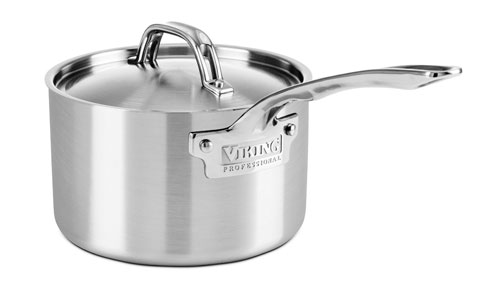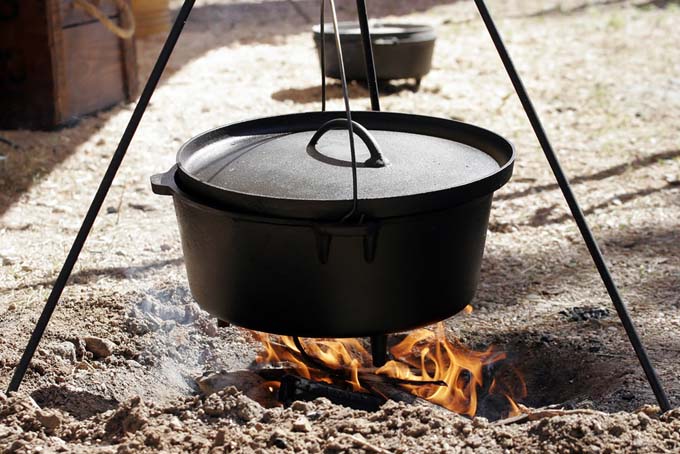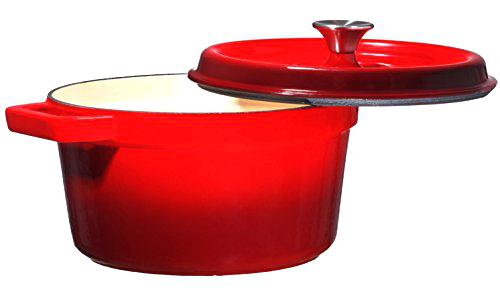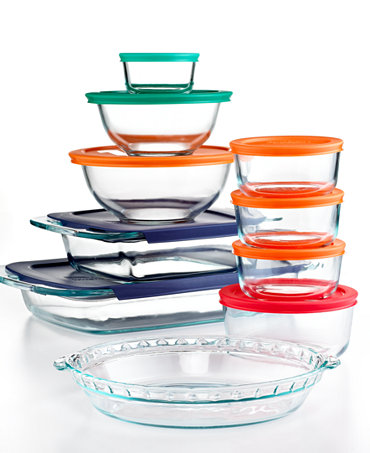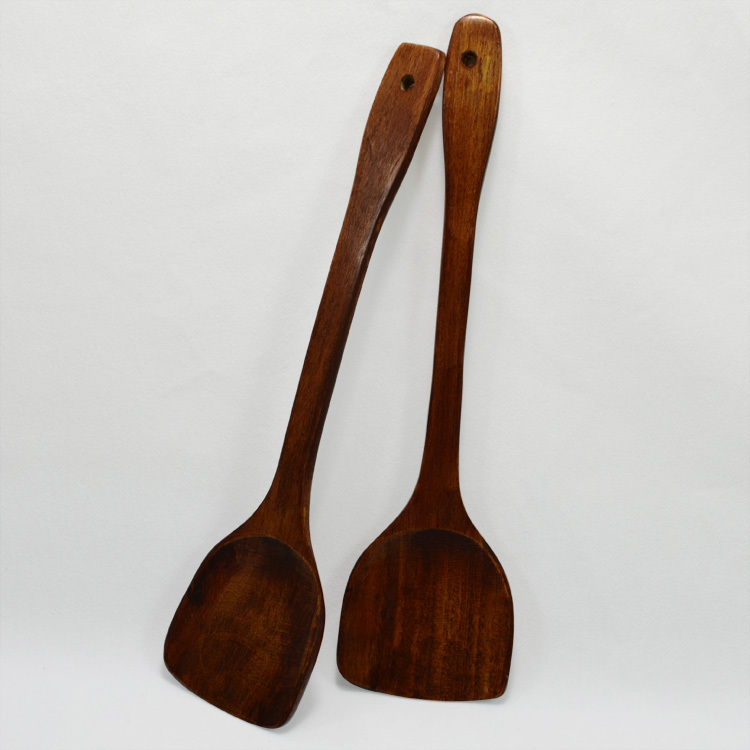Safe Nontoxic Cookware
Safe cookware doesn’t have to be expensive or inconvenient. This article will tell you what kind of cookware and how to get it affordably.
Why Nonstick Pans Are Unsafe
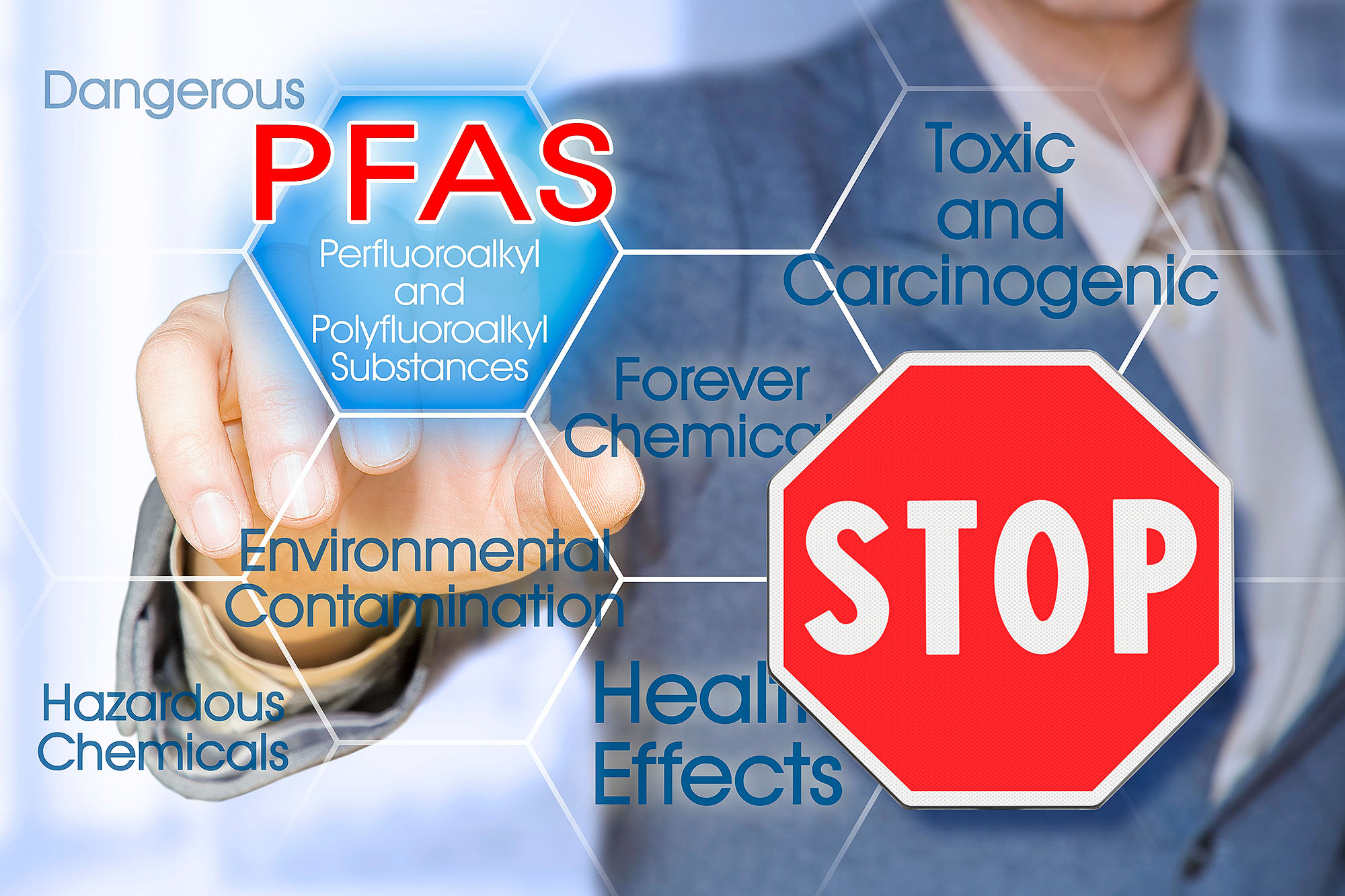
When pans are heated, toxic chemicals called PFAs are released into the food and air.
PFAs are called “forever chemicals” because of how long they stay in the soil, groundwater, and waterways. They are extremely toxic.
“Per- and polyfluoroalkyl substances (PFAs) are a group of man-made chemicals that includes PFOA, PFOS, PFTE, and many other chemicals. PFAs have been manufactured and used in a variety of industries around the globe, including in the United States since the 1940s.” -Environmental Protection Agency
These fluorine-chemicals are proven to cause cancer and other serious diseases in humans as well as profound environmental contamination.
Dupont now states it’s using a safer type of PFA in its cookware but they are lying. There is no such thing- and scientific studies have proven it.
Backstory:
“Nonstick finish was first manufactured by Dupont in the late 1940’s and they brandnamed it Teflon. Teflon is made of a type of PFA. Again, PFAs “are targets of global concern due to their ubiquitous presence, persistence, and accumulation in the water, soil, and people’s bodies. The United States Environmental Protection Agency stated in 2014: “The toxicity, mobility and bioaccumulation potential of PFOS and PFOA pose potential adverse effects for the environment and human health.”
See, PFOA (Perfluorooctanoic acid) is a type of PFA. PFOA caused what is known as polymer fume fever in humans and it’s lethal to birds. It’s proven that cooking with nonstick cookware can kill birds (many owners of rescue parrots accidentally killed their pets when they inhaled the fumes).
In 2004, the DuPont company agreed to pay up to $600 million in fines and settlement costs over environmental damage caused by production of Teflon and Gore-Tex.” http://usatoday30.usatoday.com/news/science/2004-11-21-green_x.htm
“DuPont has always known more about Teflon than it let on. In 2005, the EPA fined the company $16.5 million—the largest administrative fine in the agency’s history—for covering up decades’ worth of studies indicating that PFOA could cause health problems such as cancer, birth defects, and liver damage. The company has faced a barrage of lawsuits and embarrassing studies as well as an ongoing criminal probe from the Department of Justice over its failure to report health problems among Teflon workers. One lawsuit accuses DuPont of fouling drinking water systems and contaminating its employees with PFOA.” http://www.motherjones.com/environment/2007/05/teflon-forever
“In 2016, Dupont stated that its Teflon is not made with PFOA any longer. It, and other manufacturers, negotiated a phase out program with the EPA that began in 2006 and ended in 2015 where they stopped manufacturing nonstick finish with PFOA. BUT ALL THEY DID WAS SWITCH TO A DIFFERENT TYPE OF PFA- AND ALL PFAs ARE HIGHLY TOXIC.
Dupont says the newer, short-chain PFAs are less hazardous, but they are lying- again.
For example, a recent Danish study looking into the health effects of PFAs, including the newer short-chain versions that are replacing the older long-chained ones, and found that women with higher blood levels of PFAs had a 16-fold increased risk for miscarriage.” https://www.ncbi.nlm.nih.gov/pmc/articles/PMC4388566/
The Madrid Statement, signed by more than 200 scientists from 40 countries, presents the scientific consensus on the harms of PFAs chemicals, both old and new: https://greensciencepolicy.org/madrid-statement/
“Even if you own a post-2016 Teflon pan- after reading about what the Dupont corporation is capable of, and after reading how the entire PFA chemical family is linked to serious environmental and biological toxicity, do you really trust them that their “new Teflon” is safe? As a side note, Dupont is also currently manufacturing pesticides know to cause mass honey bee death.” http://www.reuters.com/article/us-usda-honeybees-report-idUSKBN0DV12120140515
Bottomline- nonstick finishes are toxic and continue to be toxic. All PFAs are dangerous. Avoid buying products that contain them.
Why Nonstick Kitchen Appliances Are Unsafe
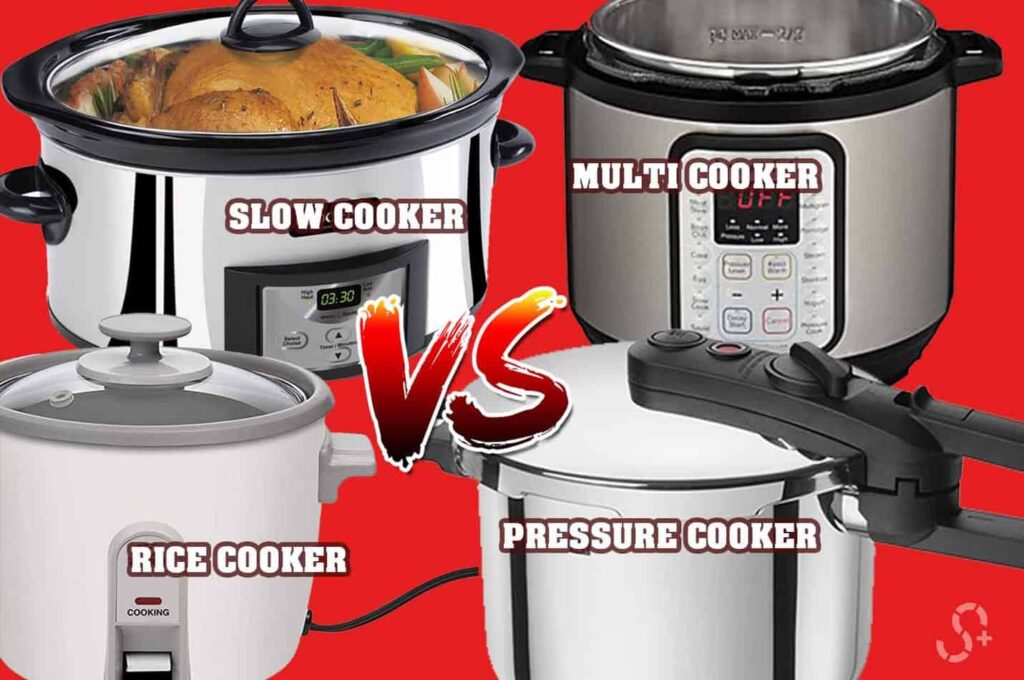
Rice cookers and slow cookers
Most slow cookers (i.e. crockpots), toasters, toaster ovens, and rice cookers have nonstick finishes in them- do not buy them. Many also have been shown to leach lead and other harmful chemicals into the food via the poorly made ceramic base or other sources such as the plastic encasing the wiring. If you want to use a slow cooker, make sure it has a stainless steel cooking vessel inside (not ceramic, or nonstick, or aluminum) and that the food only comes in contact with the steel or with glass.

Toasters
Find a toaster with plain stainless steel on the inside. Unfortunately, most contain PFAs and/or aluminum, plastic, and other harmful substances.
Avoid Antique toasters (even if they have been refurbished) because they contain asbestos, which is one of the most dangerous substances ever marketed to humankind. Antique toasters also may also contain aluminum and PFAs which are also not safe to prepare food in.
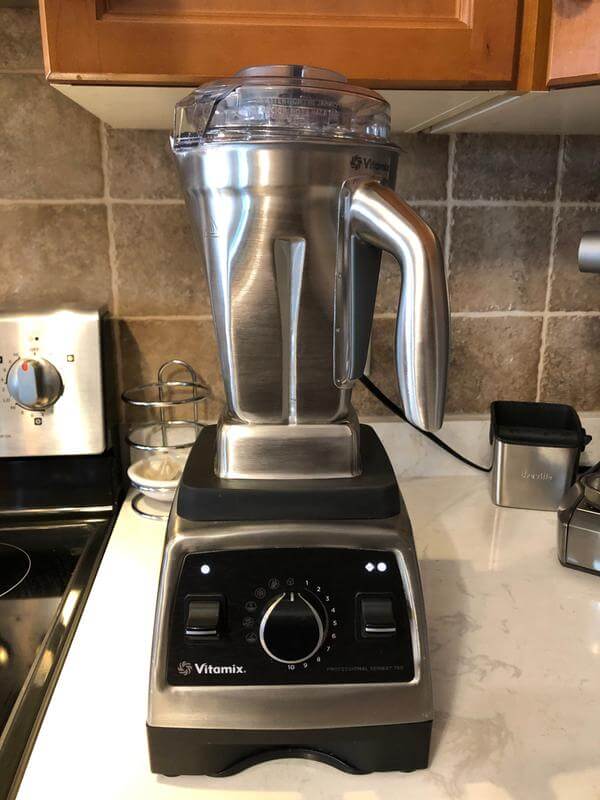
Blenders
If you have to use a blender, buy one with a glass or stainless steel container. Blenders are tough because even the expensive ones like Vitamix have a fluorine-based plastic seal that comes in contact with the food in the blender vessel. The company previously used Teflon coated plastic that flaked off in pieces into the food. Vitamix now states that the plastic seal is still Teflon, but is now enclosed inside a different type of plastic. I called Vitamix customer service and the first associate refused to identify the type of plastic that now encases the PTFE (Teflon) seal. NOT GOOD. The second associate I called identified the plastic as FKM rubber. FKM rubber has a high fluorine content. Fluorine is the main component in PFAs which are all toxic. So probably what Vitamix has done is replaced one type of PFA with another. Here’s some more info on FKM rubber: http://www.industrialrubbergoods.com/fluoroelastomers.html
I’m not saying one must stop using their Vitamix, but there are some alternatives to electric blenders which I’ll list later in this article.
Note: If you use a blender, make sure the container is made of glass or stainless steel. Tiny bits of plastic called nanoparticles are released into the food when the food is whirled around inside of a plastic bender container.
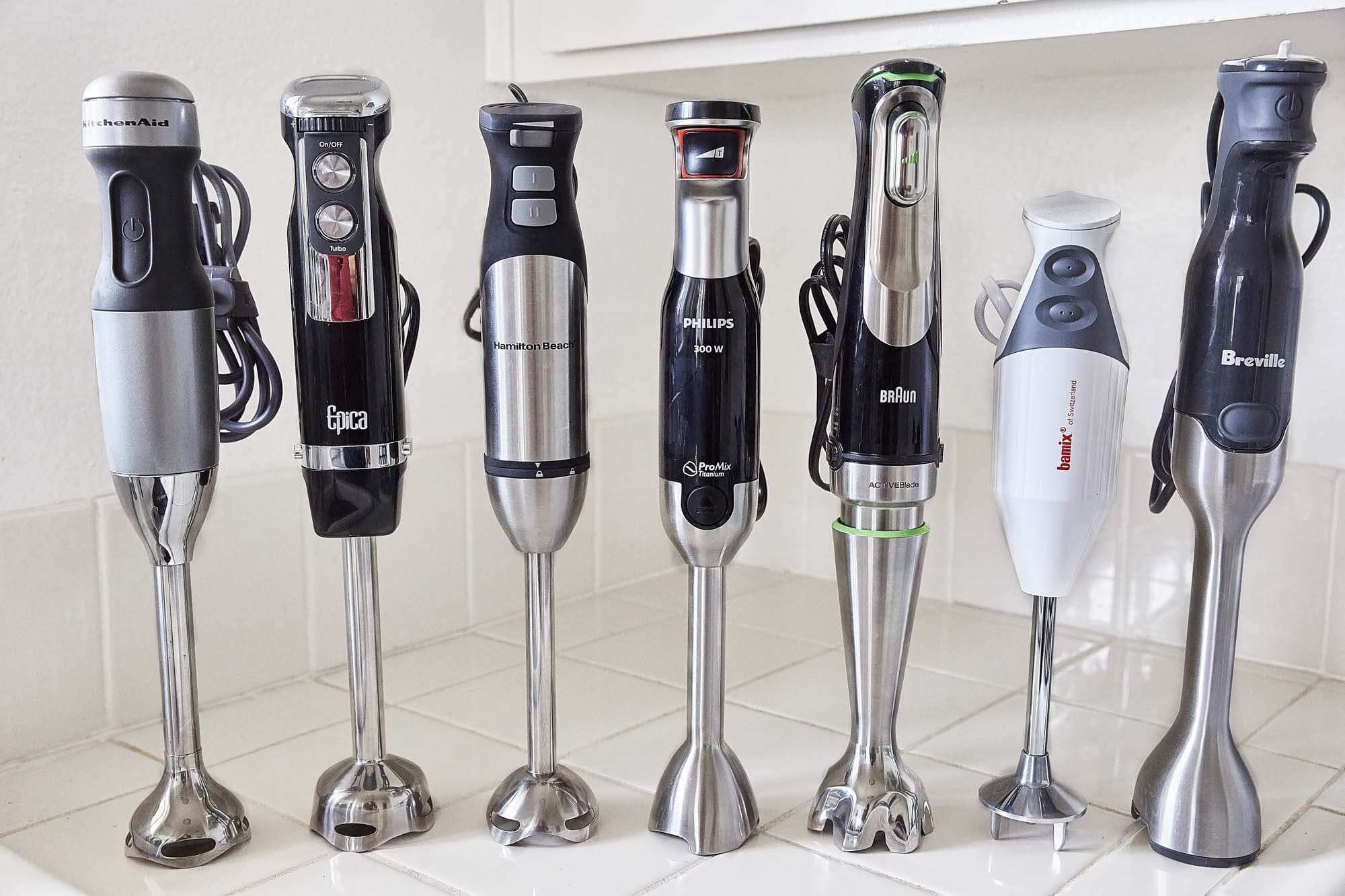
Immersion Blenders
Many immersion blenders (hand blenders) have the same problem where the Teflon seals above the blades come into contact with the food. The Bamix immersion blender has rubber seals (what kind of rubber I don’t know because the company would not provide that information to me when I requested it) that come into contact with food. Also, immersion blenders contain toxic chlorinated paraffin. More on that below. Again, not saying one should necessarily stop using these devices, but make sure they are in good working order and that the wand and blades of the blender are not aluminum.
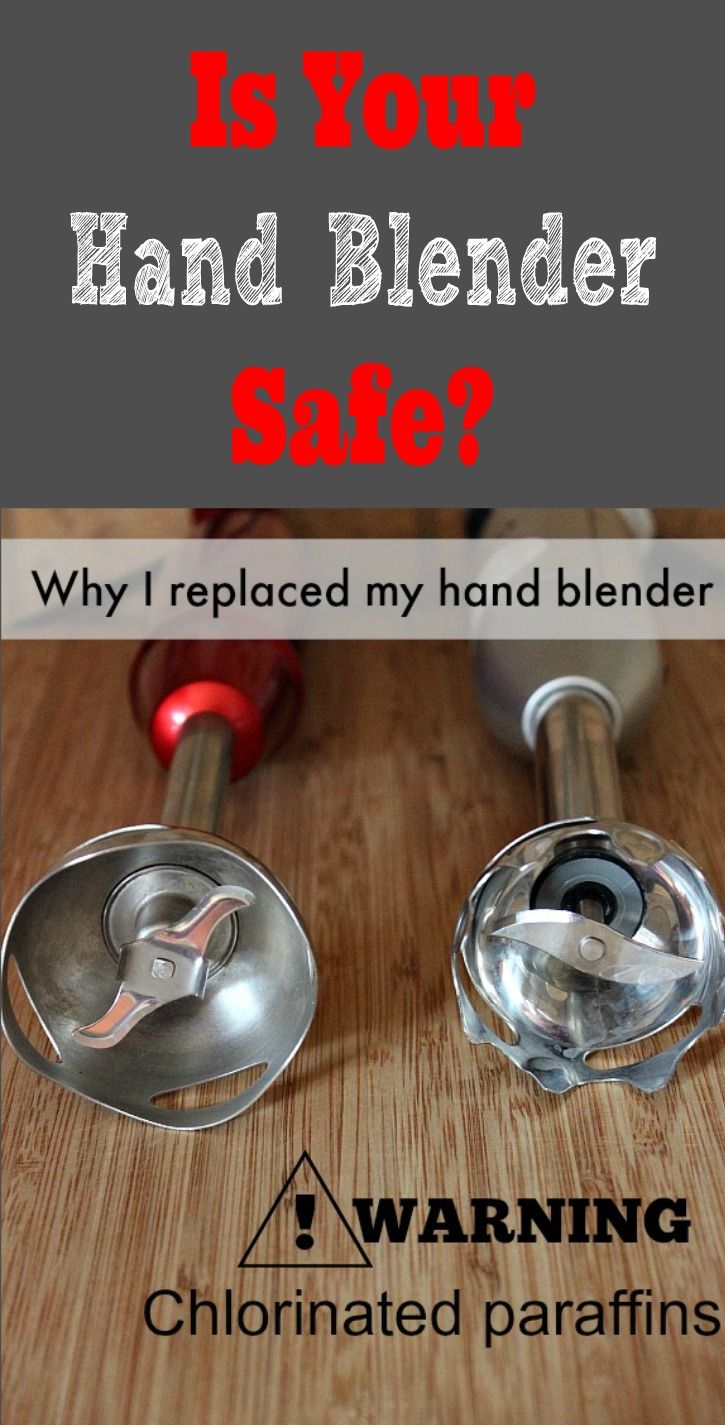
Chlorinated Paraffins In Small Kitchen Appliances
Kitchen appliances with motors have health risks because of the presence of chlorinated paraffins within the motor assemblies. Chlorinated paraffins are extremely toxic chemicals that are present in the motors of small kitchen devices and have been shown to contaminate the food at unsafe levels.
A study released on October 23, 2014 showed that some hand blenders leak chlorinated paraffins at dangerous levels. Chlorinated paraffins are a type of chemical found in flame retardants, plasticizers, motor lubricating fluids and more. CPs are classified as toxic to aquatic organisms, and carcinogenic to rats and mice. Short Chain Chlorinated Paraffins (SCCPs) are categorized in group 2B as possibly carcinogenic to humans from the International Agency for Research on Cancer. CPs build up inside the body and cause serious harm over time. They also last for decades in water and soil.
The Study: https://www.thedoctorwillseeyounow.com/content/public_health/art4511.html
Chlorinated paraffins are still legal in the US. In the European Union, the short chain chlorinated paraffins are banned, but the medium and long chain ones are still legal. Devices manufactured in the European Union are marginally safer than ones in the US, but until all chlorinated paraffins are outlawed, one might avoid using motorized kitchen appliances that point down into the food, such as immersion blenders. Or at least, conduct regular inspections of the appliance to help ensure no oil leakage.
With regards to chlorinated paraffins, it’s probably safer to use upright blenders in the sense that less chlorinated paraffins can get up into the container, maybe none.
As far as immersion blenders go, if you must use one, pick one where the driveshaft is made of stainless steel. Cuisinart makes a good affordable stainless steel immersion blender. Bamix is considered the gold standard of hand blenders but maybe it shouldn’t be because it has an aluminum bell-shaped cutter guard which comes in contact with the food (aluminum isn’t safe to cook with; more on that below) and a chromated brass driveshaft (brass can leach lead and plain chrome is not recommended for food preparation as it can also leach harmful substances into food). I’ve also seen reports of food getting stuck up in the drive shaft which is gross.
The main caveat regarding immersion blenders though is that until all chlorinated paraffins are banned, there is a risk of these chemicals dripping into the food.

Stand Mixers
Stand mixers like the Kitchenaid mixer also drip toxic oil into food: https://consumersadvisory.com/2021/02/15/whats-that-gross-gunk-coming-out-of-my-kitchenaid-stand-mixer/
Again, as long as you conduct regular inspections on the device it is probably ok.
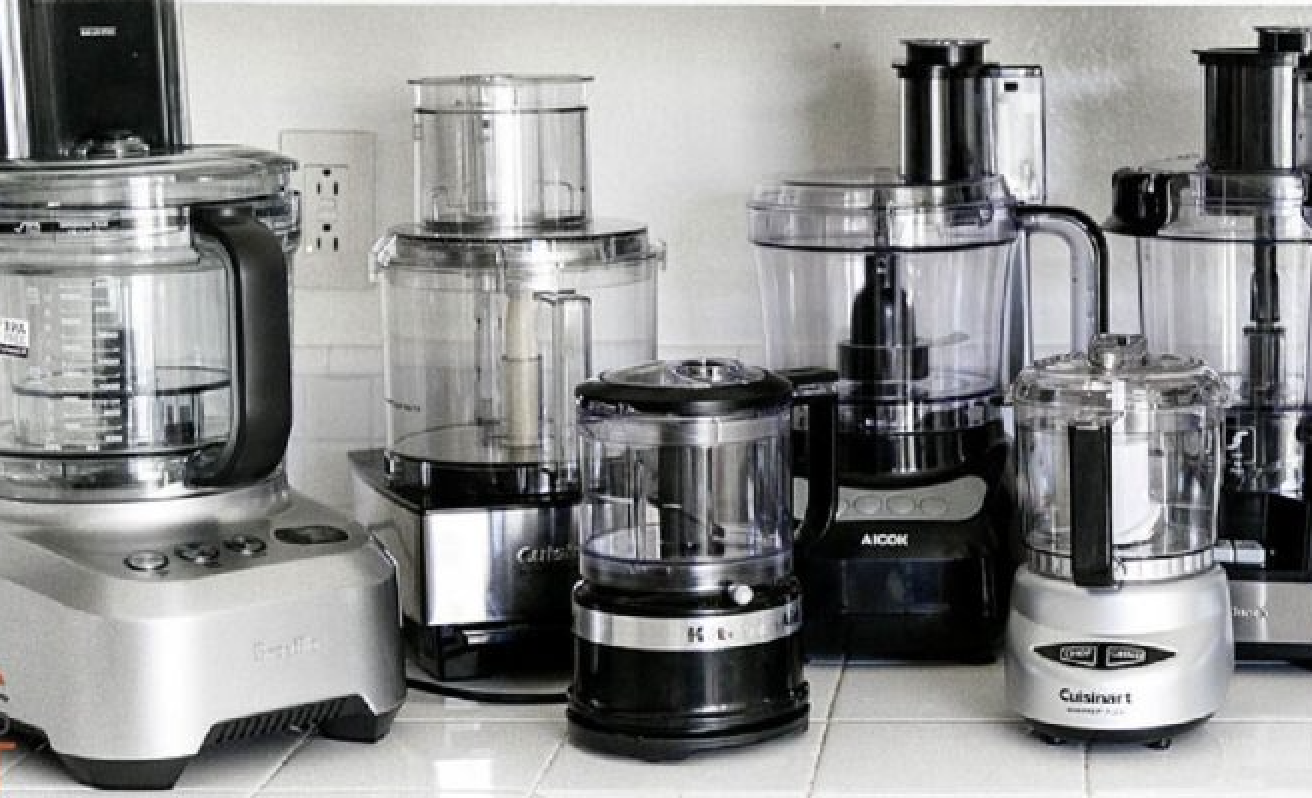
Food Processors
As for food processors, I haven’t done any research into those. I suspect they would have Teflon seals that come into contact with the food as well. If anybody has more info on food processors, please let me know.
Perhaps one is better off mixing their own doughs and chopping their own veggies. Sometimes this isn’t practical though so make sure to conduct an inspection of the appliance before and during use to see if any machine oil is present where it could make contact with the food.
Alternatives To Electric Kitchen Appliances
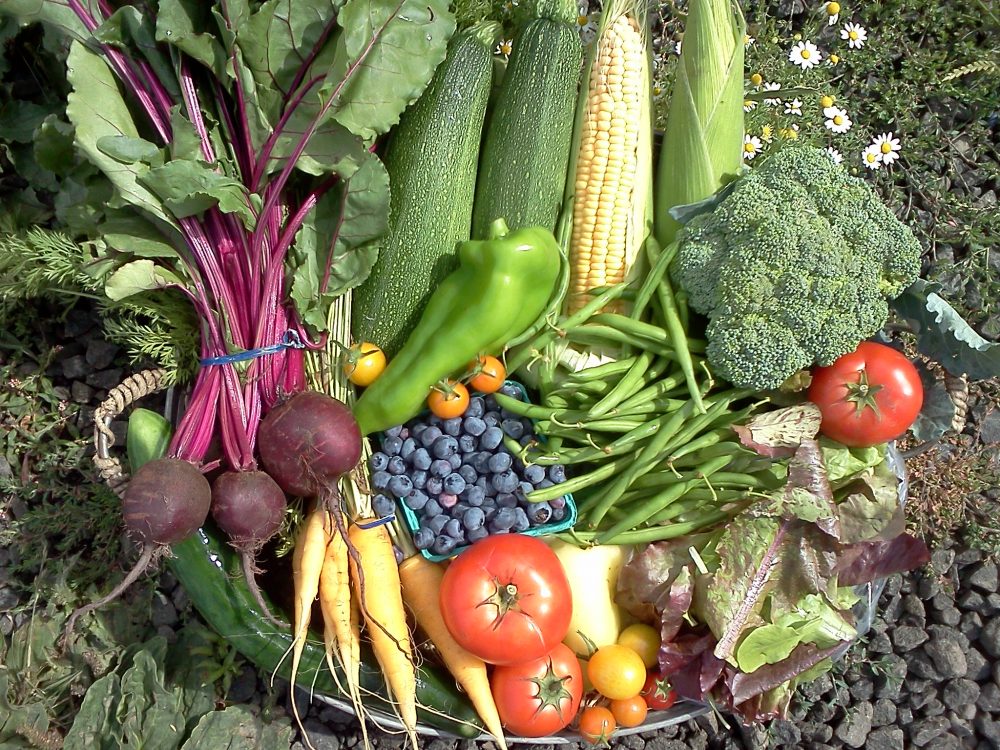
Blenders may not be necessary
There are some studies showing that it is actually healthier to consume a fruit or vegetable by chewing it and swallowing it as opposed to processing it through a blender. Digestion begins in the mouth with chewing and enzyme production found in the saliva. Not that processing a food in a blender is unhealthy thing- I myself use all these electric motorized devices. The purpose of this article is simply to get one thinking about best practices and choices when it comes to food prep tools (rather than introduce an outsized level of paranoia or dread about toxic chemicals in the kitchen which hopefully I have avoided).

Manual egg beater
A manually operated egg beater performs its duties admirably. This one is by RSVP International is made entirely from 18/8 stainless steel (except the plastic handle). No chlorinated paraffin risk here.
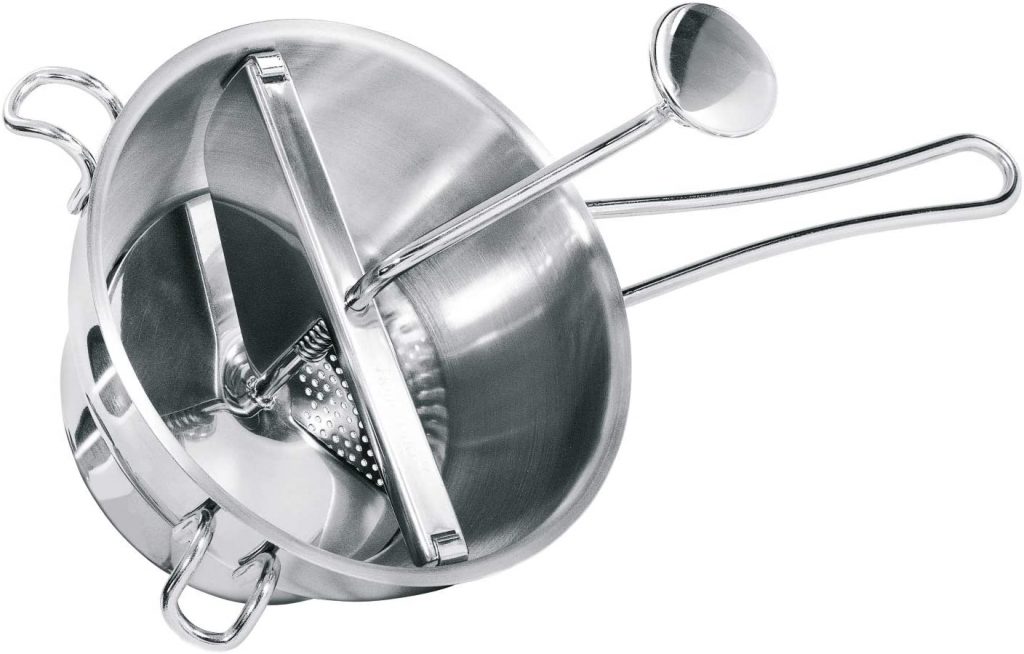
Stainless steel food mill
As for pureeing jams, soups, and baby food, an old fashioned stainless steel food mill or “mouli” is a smart choice. They come in a wide variety of sizes, designs, and price points. There are still numerous models comprised of 100% stainless steel with no plastic seals or components that make contact with the food.
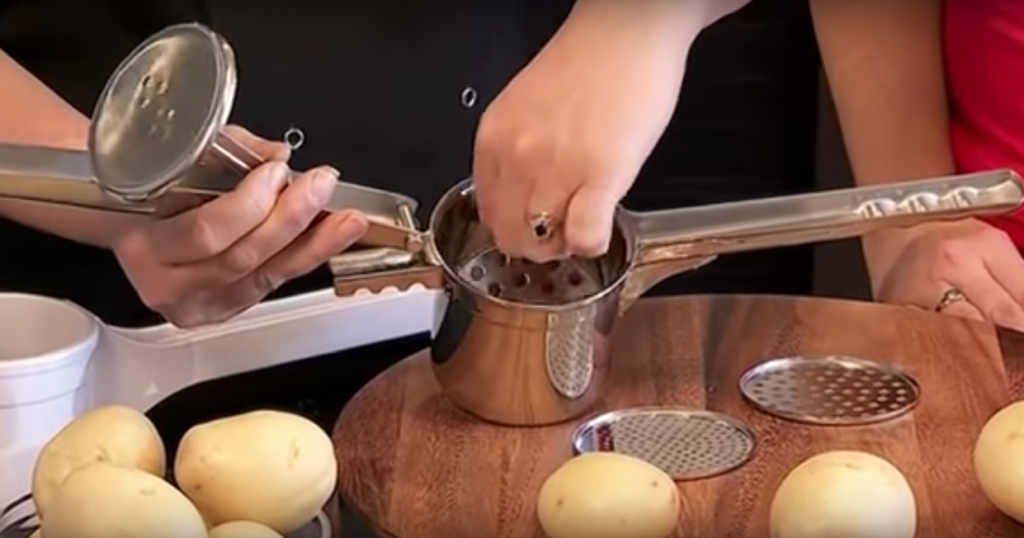
Potato Ricer
A stainless steel potato ricer is a handy device that makes fluffy mashed potatoes, and can also strain/puree baby food and soups.

Chinois
The chinois is a conical sieve with an extremely fine mesh. It is used to strain custards, purees, soups, and sauces. It produces a very smooth texture. You use a wooden mallet type tool to express the food through the sieve’s small holes.
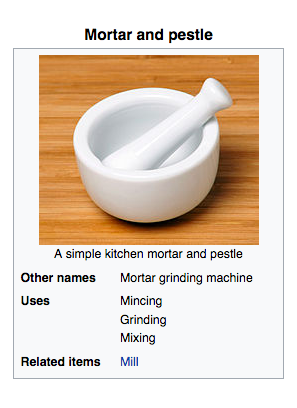
Mortar and Pestle
The mortar and pestle are ancient tools that do a great job of pulverizing food. You can make excellent guacamole in them as well as innumerable other tasty foods.
Why Silicone Cookware Is Unsafe
![]()
Silicone is a man-made polymer, but instead of a carbon backbone like plastic, it has a backbone of silicon and oxygen (Silicon is an element on the periodic table and is found in more than 90% of the minerals that make up the Earth’s crust.)
However, to make silicone polymer, silicon is passed through hydrocarbons to create a polymer with an inorganic silicon-oxygen backbone and carbon-based side groups. What all that means is that while the silicon might come from a benign and plentiful resource like sand, the hydrocarbons in silicone come from fossil sources like petroleum and natural gas. So silicone is a kind of hybrid petrochemical based material.” http://myplasticfreelife.com
Silicone has petrochemicals in it, and cooking food in plastic is always a very bad idea. These toxic petrochemicals are toxic to the human body and are proven to leach out of silicone cooking/baking materials: https://safebabyhealthychild.com/is-silicone-in-baby-products-and-bakeware-really-safe/
Why Aluminum Cookware Is Unsafe
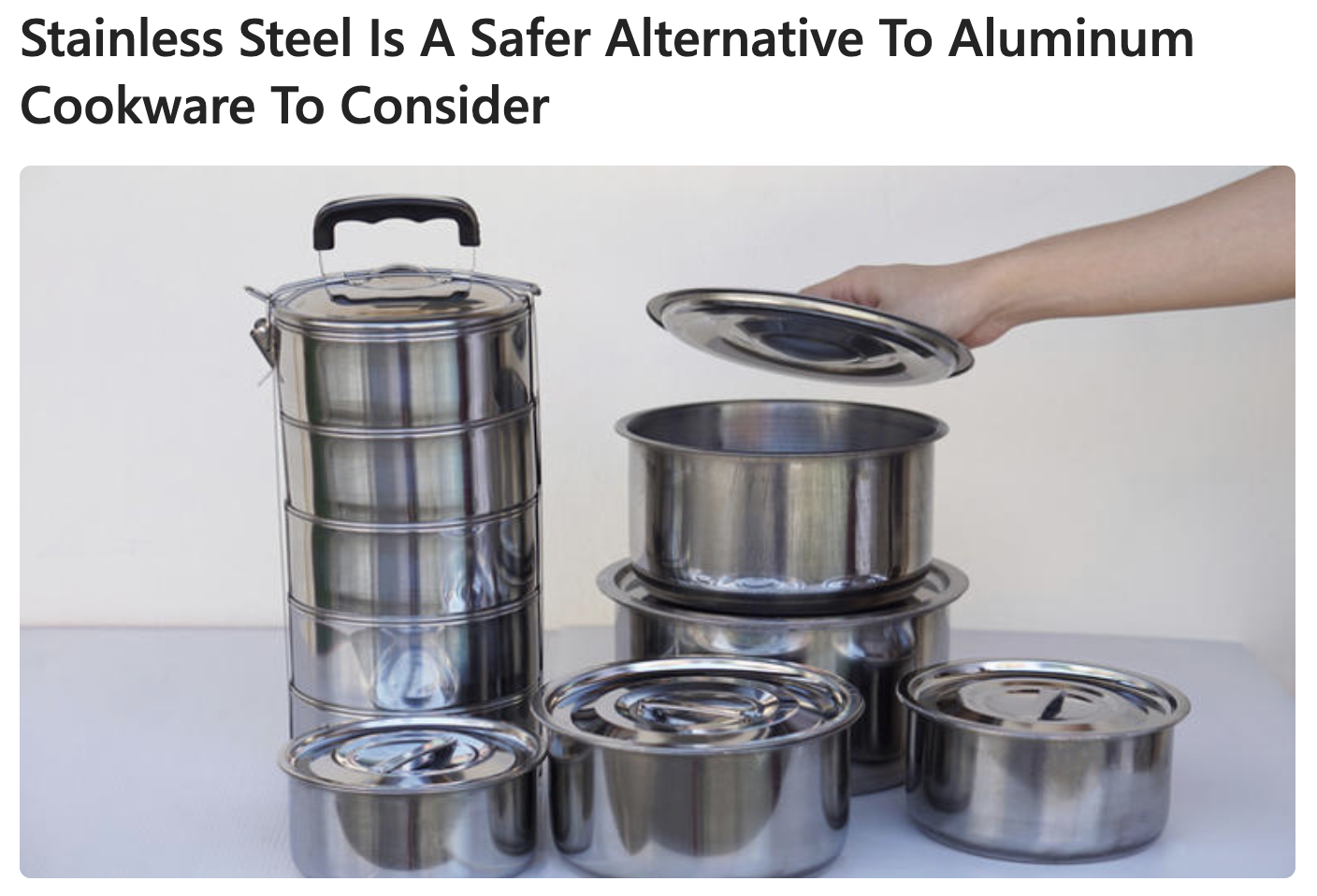
There are numerous studies linking aluminum exposure with Alzheimer’s disease. For example, a Canadian group studying brain tissue from deceased Alzheimer’s patients found that certain parts of their brains had two to three times more aluminum than a normal brain. https://www.ncbi.nlm.nih.gov/pubmed/963531
Aluminum is linked to a host of health problems including Alzheimer’s and breast cancer and if you’re baking with it, it’s leaching into your food. Don’t cook with aluminum pans (and don’t use anti perspirants either- the active ingredient in them is an aluminum derivative. Magnesium based deodorants like the brand “Deodomom” are safe and work well. You can also make your own magnesium deodorant by purchasing pharmaceutical grade magnesium hydroxide and mixing it with water.
Note: Anodized aluminum cookware is not safe to cook with either as the aluminum can leach through the anodized surface. Anodized versions are safer than non-anodized ones. However, a 2024 study published in the Journal of Exposure Science and Environmental Epidemiology found that stainless steel was even safer to cook with: https://www.nature.com/articles/s41370-024-00686-7
Why Unlined Copper Cookware Is Unsafe
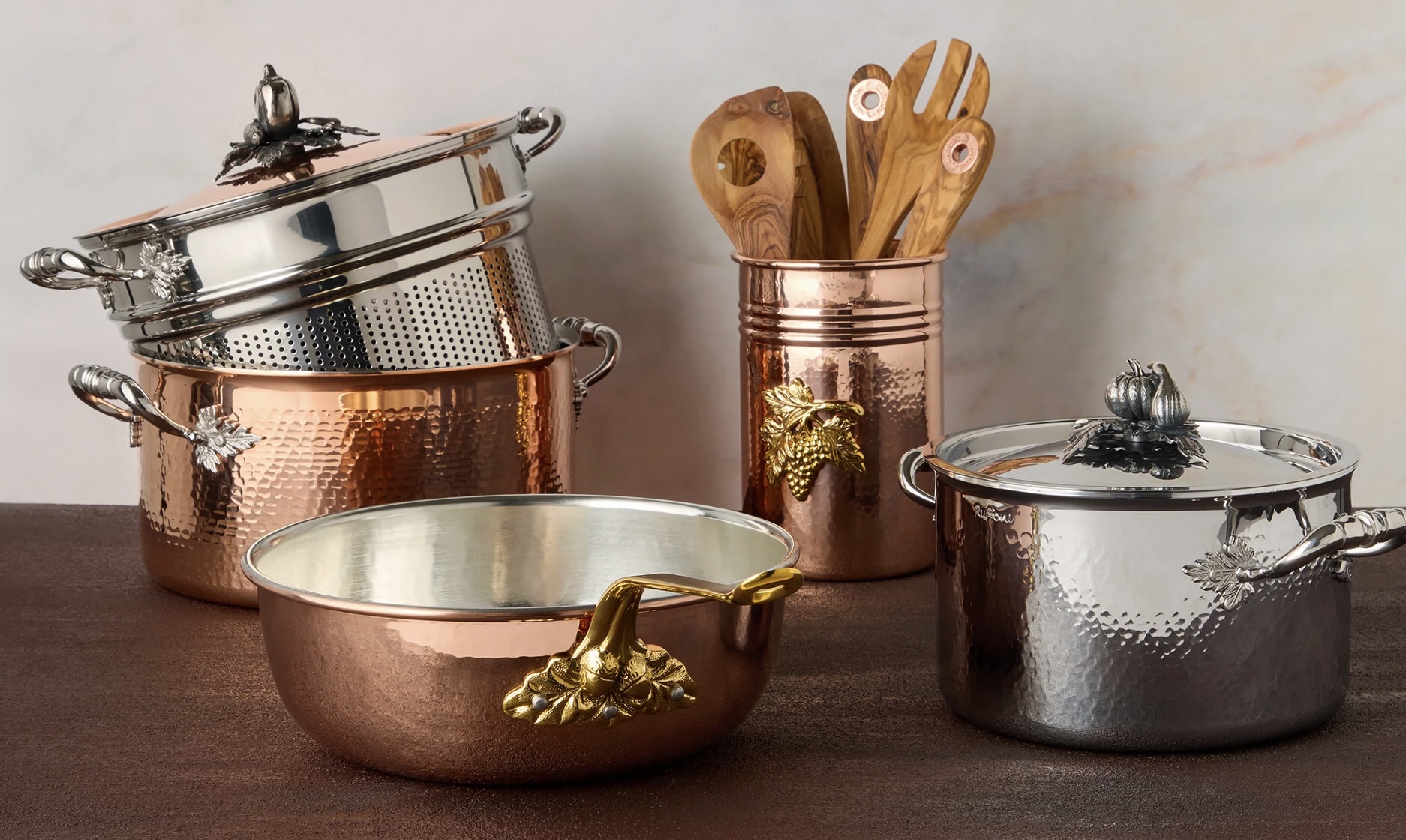
Sure it looks really pretty but “Copper is a reactive metal that can leach into food, especially when cooking acidic or high-sodium dishes. This can lead to a range of health problems, from mild symptoms like nausea and diarrhea to more serious conditions like liver damage and kidney disease.” https://homediningkitchen.com/why-is-cooking-in-copper-bad/
Why Tin-Lined Copper Cookware Is Risky

Tin is toxic when ingested. Here’s some info on that: https://www.naturalhealthgroup.com.au/heavy-metal-toxicity/tin-toxicity-tin-poisoning/
The tin lining inside copper pans is not the most stable substance and must be replaced from time to time. This is because it is a relatively soft, delicate metal and it has a melting point of only 230 degrees Celsius, after which it can assimilate into the food. Tin coatings, if worn out due to repeated use or heat, can make copper ooze out into foods.
To avoid ingesting tin particles, use stainless steel pans instead of tin. Also, copper is toxic to cook in which is why they line it with tin in the first place.
But if you have your heart set on using a lined copper pot, there are stainless steel-lined ones. They are probably quite expensive however. Copper cookware generally is. Plus it is very high maintenance and requires mucho polishing. Stainless steel cookware is much easier to care for and maintain. The best of both worlds are stainless steel vessels with copper layers (plys) sandwiched between stainless steel layers- this type of cookware is safe, easy to maintain, and has superior heat distribution. But it can be expensive if one buys it at full price. Plain old stainless steel works pretty much just as well. You never have to spend a lot of money in order to have safe cookware.
Why NonStick Ceramic Cookware Is Unsafe

These are relatively new in the market place. Manufacturers do not state how exactly the ceramic coating is adhered to the pan or what exactly the coating is comprised of. Companies lied for decades about the dangers of traditional nonstick coatings, so don’t trust them to be honest about ceramic nonstick products either.
I do not recommend “non stick ceramic” pots and pans. The ceramic spray-on compounds used to make these patented ceramic layers need to be further investigated. Their manufacturers state they do not contain harmful substances like lead and cadmium but companies do not always tell the truth, as evidenced by DuPont and many others.
Ceramic compounds also may contain harmful nanoparticles
Nanoparticles are so small they can cross the blood brain barrier and even enter individual cells. Their interactions with proteins and other components of the body can be very harmful. Here is more info: https://ec.europa.eu/health/scientific_committees/opinions_layman/en/nanotechnologies/l-2/6-health-effects-nanoparticles.htm
Here’s someone’s experience using nonstick ceramic cookware: (they appeared to off-gas toxic VOCs (volatile organic compounds) and within a few months lost their nonstick capability):
“We didn’t notice any smell off gassing from using the GreenLife pans for the first time. In fact, we were pretty darn happy with them. But after a couple months, we started noticing something really strange. Every time we cooked in our GreenLife pans, our air purifier would go crazy. I have an AIRDOCTOR Air Purifier. It has a VOC sensor that automatically adjust the air purification depending on what’s going on in the house.
When the air was relatively low in VOCs, the air purifier would be green and run silently. But as VOC levels increase in the air, the AIRDOCTOR changes color and speeds up the fan, which becomes very loud.
We had an open concept kitchen and living room. And EVERY TIME we used our GreenLife pans, the air purifier would go into what we called “death con” mode. The lights would become red and the fan would be so loud that it was hard to hear the TV over it. And the air purifier would remain that way for up to an hour after cooking. While I realize that it could be a variety of things increasing the VOC levels while cooking, we did try all kinds of cooking, from pan frying to just heating up liquids in the ceramic coated cookware. And every time the air purifier went crazy.
Can I say for sure it was the GreenLife pans? Nope.
But what I can say for sure is that the GreenLife pans definitely had a chipped coating not too long after we started using them. While I tried to use the plastic utensils (which I HATE but are necessary with non-stick cookware) included in my GreenLife cookware set as much as possible (even though they were shredding and melting after a while), my husband would sometimes use metal cooking utensils. So that’s a problem, for sure.
And we put our cookware in the dishwasher, too. Because I don’t have time to pamper pots and pans.
We also soon found that food stuck onto the ceramic coated pans very easily. Frying onions would leave a black residue that was extremely hard to get off. And over time I realized that baked-on food was just not coming off very well.
For all of these reasons, plus the fact that these pans simply won’t stand the test of time as an investment, I wouldn’t buy ceramic coated cookware again.”
source: https://www.getgreenbewell.com/nonstick-ceramic-cookware-is-the-coating-safe/
Titanium Cookware?
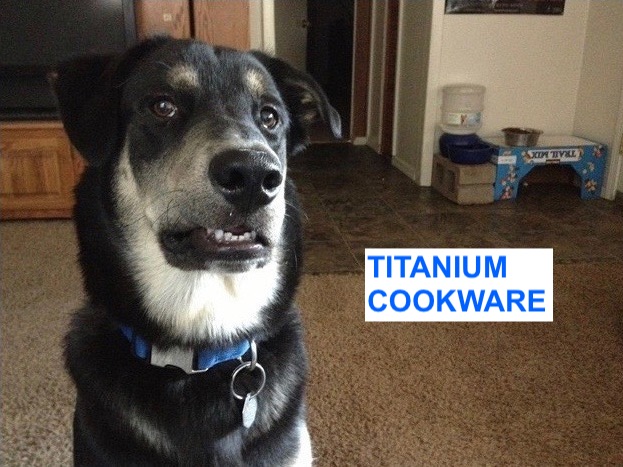
Titanium does not conduct heat very well, making it a poor choice for use in cookware. It is not naturally nonstick either (though some companies market it as such), and usually has some kind of PFA or chemical ceramic coating applied to render it so. I’d pass on anything this goofy and overpriced.
The Solution: Stainless Steel
Stainless steel is the ideal material to cook and bake with. And it doesn’t have to be expensive.
First, here’s some info on stainless steel.
Steel is an alloy of iron and carbon. Iron and carbon are elements. But not all steels are the same. You want to cook with food grade stainless steel which is designated as 304 grade stainless steel. It is also designated as 18/10 or 18/8 stainless steel. “304 grade” and “18/10” and “18/8” all mean exactly the same thing.
304 grade stainless steel is required by law to be manufactured with 18% chromium and 8-10% nickel. This is why 18/10 and 18/8 stainless steel are the exact same thing (the 18 refers to the chromium content and the 8 or 10 is referring to the acceptable range of nickel inside it. 18/10 isn’t better than 18/8, it’s kind of a marketing ploy to make it sound fancier but again, they refer to the exact same thing- food grade 304 stainless steel that contains 8% to 10% nickel.
This kind of steel is very hardy, made to withstand exposure to water, acidic foods, and soapy washings without rusting. Chromium, commonly known as chrome, makes the steel very strong, resistant to high temperatures, and to corrosion (rust).
Nickel also imparts valuable corrosion resistance. The way to tell if the stainless steel has nickel in it is by applying a magnet to the surface- nickel is not magnetic. If the magnet sticks to the steel, it means there is not much, if any, nickel in there and it will corrode a little faster.
Here’s why stainless steel is rust resistant: “The chromium in the steel combines with oxygen in the atmosphere to form a thin, invisible layer of chrome-containing oxide, called the passive film. The sizes of chromium atoms and their oxides are similar, so they pack neatly together on the surface of the metal, forming a stable layer only a few atoms thick. If the metal is cut or scratched and the passive film is disrupted, more oxide will quickly form and recover the exposed surface, protecting it from oxidative corrosion.” https://www.thoughtco.com/why-stainless-steel-is-stainless-602296
*A quick note about 18/0 stainless steel: it is a little less expensive because it has no nickel in it and thus will rust a little quicker, but it is still a good, toxin-free choice and is perfectly safe. Some pots have a 18/10 stainless steel on their cooking surfaces and 18/0 stainless steel on the bottoms so that they can work on induction cook tops.
Stainless steel can be expensive but you can still find affordable great pieces. If one is on budget, it’s best to go for a middle ground price point. There are pieces for around 30-40 dollars which are good, and as long as you purchase them from a reputable store with a good return policy then you can always return it if it turns out to be poor quality.
Purchase stainless steel cookware that is Made In The USA if possible. Again, there is very little quality control in products coming out of China. You may be able to find some good stainless steel cookware that is Made in China but really check it out once you purchase it and keep the receipt in case you need to return it. It is possible to find excellent used stainless cookware as well.
Don’t buy the ultra-cheap stainless cookware going for around 20 dollars or so. The online reviews for these are sketchy, with reports of odd odors, plastic or chemical smells, discoloration, and warping. You can also find some excellent used stainless steel cookware at garage sales, second hand stores, and online.
*Note- do not buy chemically lined stainless steel
Make sure you don’t buy stainless steel cookware that has been coated with some kind of nonstick chemical. Some companies state they apply nonstick finish to their stainless steel cookware. DO NOT BUY THESE. Also avoid any kind of “electro-chemically plated” or “Silverinox finish” treatment applied to a cookware’s cooking surface. This process is apparently meant to enhance the finish or make it easier to clean but since it may weaken the structure of the stainless steel on an atomic level and cause it to leach nickel into the food. One way you can tell if the steel has been treated is it actually feels plasticky, and will become oddly discolored after cooking with it. Don’t buy anything that looks like it’s been treated with a chemical finish. Do not buy products like these: https://www.chowhound.com/post/chemically-lines-pots-demeyere-silvinox-802027
How To Make Stainless Steel “Nonstick”

Professional chefs do not use nonstick pans. They use stainless steel. Here’s how the pros make their stainless steel pans perfectly nonstick (so you can even cook scramble eggs without nightmare cleanup scenarios).
There’s two methods:
1. All you do is put the pan on high heat with some oil in it. When it is hot enough that the oil is very loose and runny and forming a mirror-like sheen on the pan when you tilt it, you can take the pan off the heat.
This next step is important: you must let the pan cool down before you do anything else. You don’t want to burn yourself and you also don’t want to interfere with the process. What is happening is, when you heated the pan with the oil in it, the microscopic pores and cracks of the stainless steel expanded. The oil is then able to sink into and seal those microscopic cracks. Once the pan cools down and contracts, the pan will be nonstick.
When the pan is cool, simply wipe the oil out with a dry towel. The pan will now be nonstick. You now have a stainless steel pan with nonstick capabilities: completely safe and nontoxic. When finished, wahs pan like usual and repeat the process when it’s time to cook again.
If you’re scrambling eggs, don’t be alarmed when there appears to be a lot of burned on stickage. Just make your eggs like usual then soak the pan in water. After it has had 30-40 mins to soak, you will easily be able to remove the residue with a plastic knife. Plastic is not as hard as steel so don’t worry about it scratching the pan.
2. The second method is easier. You just heat the pan on the stove and then you throw some water droplets onto the surface. When the water droplets “dance” and skitter around on the pan’s surface, it’s time to put a little olive oil or other lubricant down and then start cooking. This works because when the steel heats up to a certain temperature, it expands, thus sealing up the microscopic cracks food would get stuck in. https://www.allrecipes.com/how-to-make-stainless-steel-pans-nonstick-7253877
Other Kinds Of Safe Cookware
Cook With Cast Iron
Plain old cast iron is safe too. It’s an age old non-toxic way to cook. Acidic foods like tomatoes do leach iron out of the cast iron though and may cause the food to taste metallic. However, plenty of people still cook stuff like chili in their cast iron and it comes out delicious. Cast iron can actually be a good way to supplement your diet with a bit more iron
Season your cast iron with olive oil (there are directions online for how to properly season cast iron.) It’s not recommended to put it in the dishwasher. For hygienic reasons, I recommend washing cast iron cookware with soap and water by hand after you’re done cooking (some cast iron enthusiasts will say this is heresy but leaving a slick of animal fat grease inside a pan is unsanitary and unhealthy). Just wash the vessel and re-season with olive oil.
Cast iron is very economical, even when purchased brand new. At the time of this writing I believe Lodge still makes cast iron skillets in the USA but I would check to make sure they have not moved production overseas. I know Lodge porcelain enamel cast iron products are now manufactured in China. Again, there simply is not much quality control in products coming out of China. Purchasing second hand Made in the USA cast iron is also another great choice.
Carbon steel is also a safe option but it will react to acidic foods just like cast iron does. However due to positive features like superior heat retention, some people love their carbon steel pans.
Cook With Porcelain Enameled Cast Iron
This Dutch oven is an example of porcelain enameled cast iron. It’s manufactured by baking glass onto the surface of cast iron in extremely high temperatures. It is very safe and long-lasting.
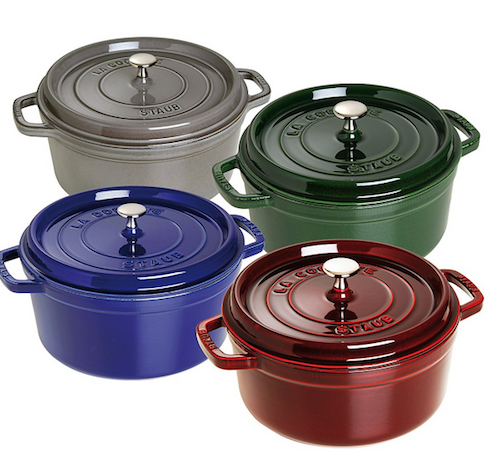
Dutch ovens can be very expensive if you’re purchasing a Le Creuset or a Staub but it is possible to find these brands on sale at their factory outlet stores or good used ones at garage sales or online.
I would not recommend buying any porcelain enamel cast iron that is made in China. Again, not always but often enough, the companies there do not adhere to strict levels of safety and quality craftsmanship. And again, ceramic can be very toxic if the wrong materials are used. For example, lead and other harmful substances have been found leaching from inferior ceramic coatings manufactured in China.
Cook With Oven-Safe Glass And Ceramic
Baking with glass or ceramic dishes made from reputable companies is a smart and affordable way to go. It’s better to buy these new as the older ones may have potentially toxic impurities in the porcelain or glass. Glass in particular can be a great and very cheap way to ensure a nontoxic food preparation experience.
Again, look for the Made In The USA label. There are also very good ceramic and glass cookware manufactured in Western Europe. I would use glass over ceramic dishes simply because ceramic glazes are a more likely to contain lead and other dangerous contaminants. Here are some safe glass and ceramic brands: https://greenchoicelifestyle.com/non-toxic-dinnerware-brands/
Other Safe Cooking Tips
Store Your Food In Glass
Pyrex makes awesome glass food storage containers with BPA-free lids so it’s really easy to keep all your leftovers in glass. Just don’t let the food make direct contact with the plastic. Glass is by far the best way to store food in the refrigerator.
Use Only Stainless Steel Or Wood Implements
Aluminum and silicone implements can leach into the food as it’s cooking. Only use stainless steel or wooden spoons/spatulas when preparing hot foods
Note: some wooden implements come from trees from slashed rainforests. Rainforests must never be cut down for any reason. Make an effort to purchase wooden tools that certify they are rainforest-safe.
Take It Easy

Safe cookware is a journey. It is impossible for most folks to replace all of their kitchen tools at once. That’s ok, every move you make towards safer cooking is a big deal and will make a difference in your and your family’s health. Take your time, know you don’t have to break the bank, and start accumulating safe pieces as time and budget allow. In store sales and deals, second hand stores, garage and estate sales, and lucky internet finds are your friends. Enjoy the process and happy cooking.

Finally, now that we’ve covered healthy cookware, here is some fascinating information culled from decades of scientific research on organic food and GMO’s: https://kimcampion.com/organic-health/all-about-gmos-genetically-modified-organisms/


